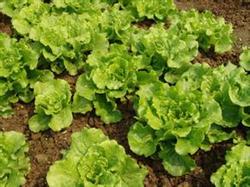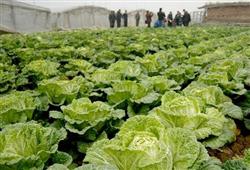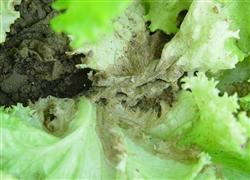What is the difference of fertilization between lettuce field and cooked vegetable field

Fertilization for different types of vegetable fields is an important measure for vegetables to achieve high quality and high yield. The author often hears from some vegetable farmers in the countryside that more fertilization has an obvious effect on increasing production in some lettuce fields (that is, the land where vegetables have just been planted), while the cooked vegetable fields where vegetables are planted all the year round are easy to cause fertilizer damage, and sometimes more fertilization will reduce the yield. In the absorption and utilization of fertilizer, the ability of vegetables depends on the "infiltration pit" produced between the concentration of sucrose in their fibers, and the pressure difference promotes the flow of nutrient solution. the water transpiration of leaves is used to pull the transpiration of roots and stems to transport and absorb fertilizers, so as to make them exchange and operate in balance and disequilibrium, so as to make vegetable plants grow and develop. In the lettuce field just planted with vegetables, the concentration of soil nutrient solution is small, the "seepage pit" is large, the signal of sucrose as the main component in the plant is strong, and the ability of regulation and control is strong. It caters to the urgent demand and rapid absorption and utilization of fertilizer for vegetables, and promotes the obvious effect of applying more fertilizer and increasing yield. On the other hand, the cooked vegetable field has a large consumption of soil nutrients and a small "seepage pit", and the ability of sucrose signal transmission and regulation in the plant is weak. Even in some cooked vegetable fields where vegetables are often grown, the role of "infiltration pit" is lost because of sufficient nutrients. Applying too much fertilizer to this kind of vegetable land will not only not promote the absorption and utilization of fertilizer by vegetables, but will lead to the hindrance of nutrients in vegetable plants. There are many physiological obstacles harmful to the normal growth of vegetables, resulting in the destruction of rotten seeds, dead seedlings, or dehydrated seedlings, rotten roots and dead seedlings, and so on. There will be some soil aging in many cooked vegetable fields where vegetables are grown all the year round. The main manifestations are the increase of bacteria and residual toxicity, soil consolidation and lack of organic matter, due to the application of a large number of chemical fertilizers such as compound fertilizer and diammonium, ignoring the application of organic fertilizer, resulting in soil hardening, decreased air permeability and decreased activity of aerobic microorganisms. the root system is underdeveloped and vulnerable to disease. Excessive application of chemical fertilizer increased the pH value of vegetable land and aggravated soil salinization. Lack of trace elements, zinc, boron, iron, molybdenum and other trace elements in continuous cropping soil for many years are absorbed by vegetables, and can not be supplemented, these trace elements will be reduced year by year, seriously affecting the growth and development of vegetables. The soil ploughing layer is shallow, the vegetable land is more manual digging, the intercropping garden connected with stubble is less, and the soil layer becomes shallower day by day, which affects the root extension, but the lettuce field generally does not have the above phenomenon because of the short planting time of vegetables. Therefore, the utilization rate of fertilization is high, and the effect of increasing production is remarkable. For these two types of vegetable fields, in order to make the vegetables grow normally and obtain the good benefit of increasing production and income, we must apply fertilizer reasonably, make the vegetable fields maintain the appropriate nutrient concentration, and let the vegetables maintain the moderate plant "seepage pit" effect. The principles of scientific fertilization are as follows: first, increase the application of a large number of mature organic fertilizers. Especially for cooked vegetables, it is advisable to stop using chemical fertilizer and single nitrogen fertilizer. The second is to adhere to the perennial application of plant straw, barnyard manure and human and animal manure and other organic fertilizers to improve the soil aggregate structure and make water, fertilizer, gas and heat obviously coordinated. For the transformation of acidified or alkalized soil, in addition to adding organic fertilizer, neutral fertilizer should also be applied appropriately. If the soil is acidic, it can be neutralized with lime or plant ash, the soil is alkaline, and it can be adjusted by ammonium sulfate or calcium superphosphate to improve the acidizing properties of vegetable soil. The third is to implement the reasonable rotation of vegetables of different families, whether it is lettuce field or cooked vegetable field, it is not suitable to grow the same kind of vegetables in the same vegetable field for several consecutive crops. Crop rotation should be done frequently. The fourth is to adhere to the scientific principle of fertilization. Keep 19 kg of pure nitrogen, 7 kg of available phosphorus and 30 kg of pure potassium per mu. Before fertilization, test the effective content in the soil, then calculate the variety and quantity that need to be replenished, and then determine the application method and quantity according to the variety and seedling condition. The general principle is: "lettuce fields" and vegetable fields with poor soil should be applied more, while "cooked vegetable fields" and vegetable fields with fertile soil should be applied less. The ratio of nitrogen, phosphorus and potassium is 2.5 ∶ 0.9 ∶ 5.5. Appropriate supplement of boron and zinc fertilizer, pay attention to the application of multi-element special fertilizer for vegetables. The seedlings damaged by fertilizer should be controlled in time, and the growth regulator should be sprayed outside the root. When salt or fertilizer damage occurs, water the vegetable field in time, cover the barren soil, press salt and buffer the nutrient concentration of the soil, so as to prevent vegetables from being "held up" by fertilizer.
- Prev

How to fertilize and water Chinese cabbage
From the perspective of the whole growth period of Chinese cabbage, it has to go through three stages: seedling stage, rosette stage and heart stage. Chinese cabbage absorbs less nutrients at seedling stage, accounting for only 10%, and rosette stage accounts for 30%. During this period, production should control water and fertilizer, especially nitrogen fertilizer, so that Chinese cabbage leaves grow slowly, which is also called squatting seedling stage. It can't be caused by too much moisture.
- Next

Several common diseases of lettuce and their control methods
Lettuce produced in greenhouse in winter is prone to a variety of diseases. Several common diseases and control measures of lettuce are summarized as follows: Sclerotinia sclerotiorum mainly harms the base of the stem, the disease is yellowish brown to brown water stains at the beginning, and then extends to the whole stem. cause the stem to rot or develop upward to cause leaf rot, and finally the plant withered.
Related
- Where is it suitable to grow horseradish in China? it is expected to see the middle altitude horseradish in Alishan.
- How to prevent tomato virus disease reasonably? (Control methods included)
- Many people like to plant towel gourd on the balcony. What are the main points of this method and management?
- What crops can chili peppers be mixed with?
- Fertilization techniques and matters needing attention in Tomato
- What are the grafting techniques for peach seedlings in spring?
- Harm and control methods of root swelling disease of Chinese cabbage
- What are the pests of sweet potatoes? How to prevent and cure it?
- Symptoms, causes and Control methods of navel Rot in Tomato
- The cause of "Cucumber rotten bibcock" in Farmers' planting Cucumber and its Control Plan

